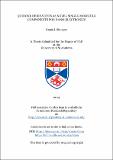Files in this item
Quinone derivatives as novel single-molecule components for nano-electronics
Item metadata
| dc.contributor.advisor | Schaub, Renald | |
| dc.contributor.author | Simpson, Grant J. | |
| dc.coverage.spatial | iv, 108 | en_US |
| dc.date.accessioned | 2015-03-24T17:04:21Z | |
| dc.date.available | 2015-03-24T17:04:21Z | |
| dc.date.issued | 2014-11 | |
| dc.identifier.uri | https://hdl.handle.net/10023/6309 | |
| dc.description.abstract | In this thesis, quinone derivative molecules supported on a Cu(110) surface are studied using scanning tunnelling microscopy (STM). The experimentally investigated system is based on the bistable nature of these compounds, and so the work is introduced in the wider context of molecular electronics (Chapter 1). The theory and experimental techniques are also described (Chapters 2 and 3). In Chapter 4 the switching behaviour of azophenine (AP) and azotolyline (AT) is characterised using STM imaging and spectroscopy, and is demonstrated to be based on a hydrogen tautomerisation reaction. The activation energy for switching is quantified by measurement of the rate of switching as a function of varying bias voltage, and the process is determined to be stimulated by inelastic electron tunnelling. The reaction pathway is also revealed using theoretical modelling. Chapter 5 focusses on the condensed phase of AP on the Cu(110) surface. The switching behaviour is found to be largely quenched in the self-assembled phase, so statistical analyses of the AP-AP and AP-Cu interactions are conducted in order to try to explain this. Chapter 6 returns to the study of isolated AP molecules and investigates the spatial dependence of the switch with respect to the location of electronic excitation. It is shown that the final state of the molecule can be accurately selected by exciting specific functional groups within the molecule. This control originates from the non-degenerate reaction pathways for the sequential transfer of the two tautomeric protons. The work is then discussed in terms of future outlook and potential applications for bistable molecules. | en_US |
| dc.language.iso | en | en_US |
| dc.publisher | University of St Andrews | |
| dc.subject.lcc | TK9874.84S5 | |
| dc.subject.lcsh | Quinone--Derivatives | en_US |
| dc.subject.lcsh | Nanoelectronics | en_US |
| dc.subject.lcsh | Molecular electronics | en_US |
| dc.title | Quinone derivatives as novel single-molecule components for nano-electronics | en_US |
| dc.type | Thesis | en_US |
| dc.type.qualificationlevel | Doctoral | en_US |
| dc.type.qualificationname | PhD Doctor of Philosophy | en_US |
| dc.publisher.institution | The University of St Andrews | en_US |
| dc.rights.embargoreason | Embargo period has ended, thesis made available in accordance with University regulations. | en_US |
| dc.identifier.doi | https://doi.org/10.17630/10023-6309 |
This item appears in the following Collection(s)
Items in the St Andrews Research Repository are protected by copyright, with all rights reserved, unless otherwise indicated.

